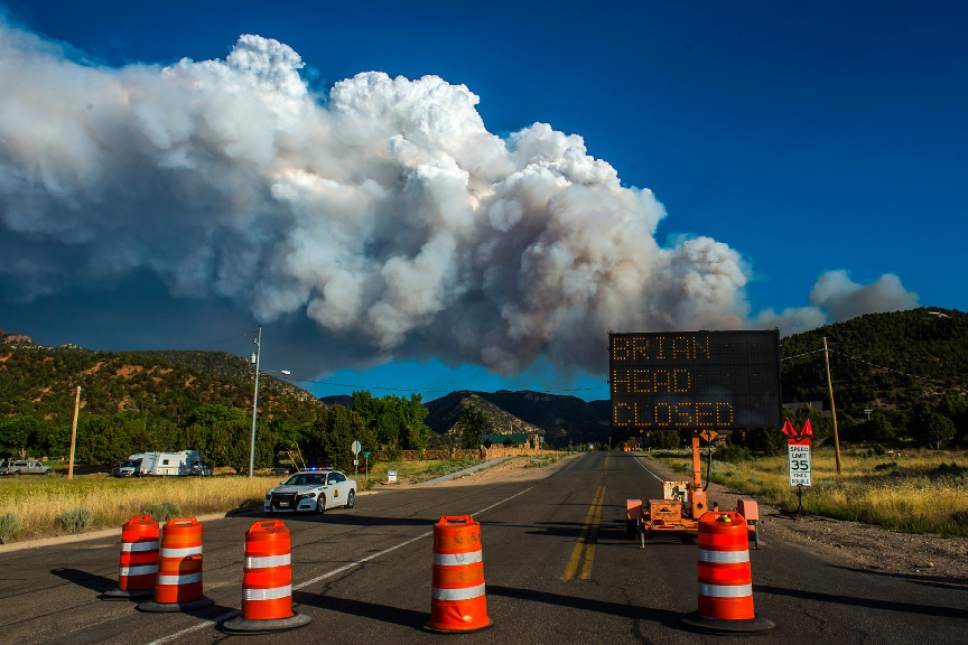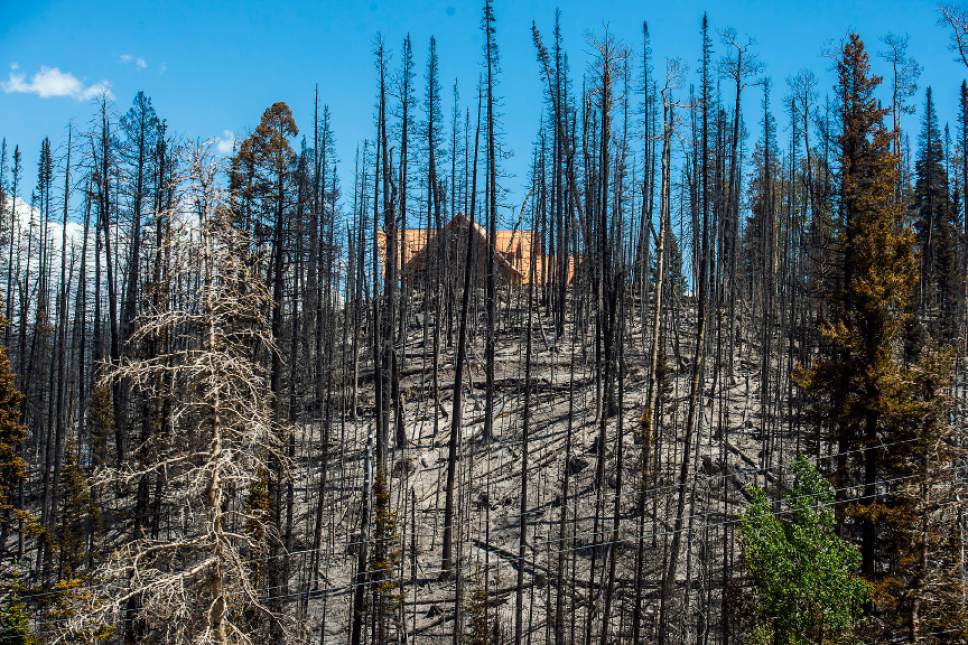This is an archived article that was published on sltrib.com in 2017, and information in the article may be outdated. It is provided only for personal research purposes and may not be reprinted.
Southern Utah politicians on Monday blamed the Brian Head Fire's fast pace and destructiveness on environmentalists who, they said, for decades have thwarted logging of trees killed by bark beetles.
But the targeted groups contend climate change and excluding fire from the landscape are the real reasons Utah's national forest are primed for blazes.
Without citing a source, Rep. Mike Noel angrily alleged environmentalists would rather see the Dixie National Forest burn than see a single stump.
"When we turned the Forest Service over to the bird and bunny lovers and the tree-huggers and the rock-lickers, we turned our history over," the Kanab Republican said at a news conference in Brian Head.
"We're going to lose our watershed and we're going to lose our soils and we're going to lose our wildlife and were going to lose our scenery — the very things you people wanted to protect," Noel added. "It's just plain stupidity."
He called out the inactive Friends of Dixie National Forest, which once fought timber harvests, as well as the Southern Utah Wilderness Alliance (SUWA) and the Grand Canyon Trust — two prominent organizations that do not litigate timber harvests.
"Noel and others are exploiting this fire to mislead the public. The truth is that climate change, drought, historic fire suppression and wind all play roles in the severity of fires. There is no single cause and no easy solution," SUWA legal director Steve Bloch said. "It's shameful that Noel would seize on the dire straits folks find themselves in to fan the flames with his rhetoric."
Staffers with the two groups say Noel's tirade amounted to slander that mischaracterizes their positions in an attempt to vilify environmentalism and divert attention from the true causes of poor forest health.
"There is no attribution. He makes up a quote and [then] attacks it," Bloch said. "We share his admiration of the firefighters. They have done tremendous work. It is unfortunate folks are losing their property. It's always unfortunate if anybody's life is at risk."
But scapegoating environmental groups serves no legitimate purpose, Bloch said.
In the 1990s, as a beetle epidemic spread across the Dixie National Forest, officials there proposed a number of salvage harvests. Many of those plans drew appeals because they tapped roadless terrain and old growth. While some were blocked, other harvests went forward.
Although logging litigation has largely disappeared in recent years, the Forest Service is not approving those projects fast enough to satisfy state officials.
Lt. Gov. Spencer Cox said there is "no question our inability to manage the forest the way it should be managed has led to more destruction."
Not since the Seeley burn, which torched 48,000 acres around Huntington Canyon in 2012, has Utah seen a fire so costly and destructive as the Brian Head blaze.
The main reason, Noel asserted, is a buildup of fuels from a failure to log, especially expanses hit by bark beetles.
"There are 70 million board feet of timber being grown every year and you allow a harvest of 6 million board feet. That's 66 million [sic] board feet of fire. When you allow trees to die from bark beetle .... you are going to get a catastrophic fire," he fumed. "We haven't seen this in 28 years, because we haven't done stupid stuff like this in 28 years."
Noel compared two photographs — taken by Garfield County Sheriff Danny Perkins — that the lawmaker said proves the benefits of logging. One picture showed a logged area, depicted by tree stumps among unburned trees, while the other depicted an unlogged area that burned.
Scientists agree that the devastating beetle assault on Western forests has implications for wildfires. But they insist they need more research to know how much of an effect those dead trees have on such blazes.
Echoing Noel's sentiments "100 percent," Garfield County Commissioner David Tebbs referred to SUWA as the "Southern Utah Destruction Alliance," even though that group has steered clear of timber litigation for years in favor of a mission toward preserving redrock wilderness.
The Utah county with the largest portion of its land in forest preserves, Garfield is far more dependent on tourism than its timber after a decline in logging since the 1980s.
"We could be an economy that thrives on timber production. We do need a mixed approach. There would be some fire to that. There would need to be some timber extrication. We need to bring that back," Tebbs said. "It's really sad to see those resources completely destroyed because of the environmental movements that have come into our area."
Mary O'Brien of the Grand Canyon Trust contends Utah politicians are taking a simplistic view that the only way to prevent fire is to cut down trees. Forest health can be restored through thinning and prescribed burning, she argued.
"There is no questions we are in a world of hurt in the forest because people wanted the Forest Service to suppress fires so they cut everything for timber. So, yeah, past policies have made for greater fuel loads," O'Brien said. "It's just not going to solve the problem to point fingers at one cause when it's a combination of private inholdings, past policies of suppression, climate change. If groups appealed some forest [logging] projects, there might have been good reasons to appeal them, but it isn't that simple view that we didn't want any stumps."
News editor Stephen Hunt contributed to this story.
Brian Maffly covers public lands for The Salt Lake Tribune. Brian Maffly can be reached at bmaffly@sltrib.com or 801-257-8713.
Twitter: @brianmaffly









